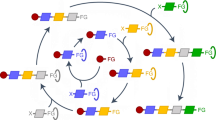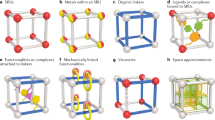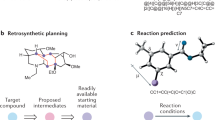Abstract
When variance is encountered in reticular structures such as metal–organic frameworks, it occurs as multiple kinds of functionalities bound and distributed in aperiodic lattices. In these multivariate systems, unknown spatial arrangements of functionalities create properties that go beyond those of their simple sum. It is therefore essential that we learn how to recognize, study and use these arrangements, and for this purpose we propose using the concept of sequences. Accordingly, we propose a classification system, outline a method for characterizing sequences and describe the application to self-propelled reticular machines. On a fundamental level, this contribution transforms the chemist’s thinking from the usual ‘make, characterize, use’ protocol of doing chemistry to a discovery routine based on finding correlations between input synthesis parameters and output performance. This approach provides an alternative and widely accessible pathway for determining the properties that the system of sequences confers on multivariate reticular structures.
This is a preview of subscription content, access via your institution
Access options
Access Nature and 54 other Nature Portfolio journals
Get Nature+, our best-value online-access subscription
$29.99 / 30 days
cancel any time
Subscribe to this journal
Receive 12 digital issues and online access to articles
$119.00 per year
only $9.92 per issue
Buy this article
- Purchase on Springer Link
- Instant access to full article PDF
Prices may be subject to local taxes which are calculated during checkout




Similar content being viewed by others
References
Freund, R. et al. 25 years of reticular chemistry. Angew. Chem. Int. Ed. 60, 23946–23974 (2021).
Jiang, H., Alezi, D. & Eddaoudi, M. A reticular chemistry guide for the design of periodic solids. Nat. Rev. Mater. 6, 466–487 (2021).
Xu, W. et al. Anisotropic reticular chemistry. Nat. Rev. Mater. 5, 764–779 (2020).
Deng, H. et al. Multiple functional groups of varying ratios in metal–organic frameworks. Science 327, 846–850 (2010).
Liu, Q., Cong, H. & Deng, H. Deciphering the spatial arrangement of metals and correlation to reactivity in multivariate metal–organic frameworks. J. Am. Chem. Soc. 138, 13822–13825 (2016).
Meekel, E. G. & Goodwin, A. L. Correlated disorder in metal–organic frameworks. CrystEngComm 23, 2915–2922 (2021).
Kong, X. et al. Mapping of functional groups in metal–organic frameworks. Science 341, 882–885 (2013).
Sue, A. C.-H. et al. Heterogeneity of functional groups in a metal–organic framework displays magic number ratios. Proc. Natl Acad. Sci. USA 112, 5591–5596 (2015).
Ji, Z., Li, T. & Yaghi, O. M. Sequencing of metals in multivariate metal–organic frameworks. Science 369, 674–780 (2020).
Furukawa, H., Müller, U. & Yaghi, O. M. ‘Heterogeneity within order’ in metal–organic frameworks. Angew. Chem. Int. Ed. 54, 3417–3430 (2015).
Xia, Q. et al. Multivariate metal–organic frameworks as multifunctional heterogeneous asymmetric catalysts for sequential reactions. J. Am. Chem. Soc. 139, 8259–8266 (2017).
Zhai, Q.-G., Bu, X., Mao, C., Zhao, X. & Feng, P. Systematic and dramatic tuning on gas sorption performance in heterometallic metal–organic frameworks. J. Am. Chem. Soc. 138, 2524–2527 (2016).
Feng, Y., Chen, Q., Jiang, M. & Yao, J. Tailoring the properties of UiO-66 through defect engineering: a review. Ind. Eng. Chem. Res. 58, 17646–17659 (2019).
Taddei, M. When defects turn into virtues: the curious case of zirconium-based metal–organic frameworks. Coord. Chem. Rev. 343, 1–24 (2017).
Cadman, L. K. et al. Compositional control of pore geometry in multivariate metal–organic frameworks: an experimental and computational study. Dalton Trans. 45, 4316–4326 (2016).
Yuan, S. et al. Continuous variation of lattice dimensions and pore sizes in metal–organic frameworks. J. Am. Chem. Soc. 142, 4732–4738 (2020).
Ehrling, S. et al. Adaptive response of a metal–organic framework through reversible disorder–disorder transitions. Nat. Chem. 13, 568–574 (2021).
Bennett, T. D., Cheetham, A. K., Fuchs, A. H. & Coudert, F.-X. Interplay between defects, disorder and flexibility in metal–organic frameworks. Nat. Chem. 9, 11–16 (2016).
Islamov, M., Babaei, H. & Wilmer, C. E. Influence of missing linker defects on the thermal conductivity of metal–organic framework HKUST-1. ACS Appl. Mater. Interfaces 12, 56172–56177 (2020).
Krivovichev, S. V. Which inorganic structures are the most complex? Angew. Chem. Int. Ed. 53, 654–661 (2014).
Krivovichev, S. V. Structural and topological complexity of zeolites: an information-theoretic analysis. Microporous Mesoporous Mater. 171, 223–229 (2013).
Simonov, A. & Goodwin, A. L. Designing disorder into crystalline materials. Nat. Rev. Chem. 4, 657–673 (2020).
Ejsmont, A. et al. Applications of reticular diversity in metal–organic frameworks: an ever-evolving state of the art. Coord. Chem. Rev. 430, 213655 (2021).
Gándara, F. & Bennett, T. D. Crystallography of metal-organic frameworks. IUCrJ 1, 563–570 (2014).
Ockwig, N. W., Delgado-Friedrichs, O., O’Keeffe, M. & Yaghi, O. M. Reticular chemistry: occurrence and taxonomy of nets and grammar for the design of frameworks. Acc. Chem. Res. 38, 176–182 (2005).
Zhang, Y.-B. et al. Introduction of functionality, selection of topology, and enhancement of gas adsorption in multivariate metal-organic framework-177. J. Am. Chem. Soc. 137, 2641–2650 (2015).
Li, S., Chung, Y. G., Simon, C. M. & Snurr, R. Q. High-throughput computational screening of multivariate metal-organic frameworks (MTV-MOFs) for CO2 capture. J. Phys. Chem. Lett. 8, 6135–6141 (2017).
Drummond, M. L., Cundari, T. R. & Wilson, A. K. Cooperative carbon capture capabilities in multivariate MOFs decorated with amino acid side chains: a computational study. J. Phys. Chem. C 117, 14717–14722 (2013).
Wu, Y., Duan, H. & Xi, H. Machine learning-driven insights into defects of zirconium metal–organic frameworks for enhanced ethane–ethylene separation. Chem. Mater. 32, 2986–2997 (2020).
Li, H., Eddaoudi, M., O’Keeffe, M. & Yaghi, O. M. Design and synthesis of an exceptionally stable and highly porous metal–organic framework. Nature 402, 276–279 (1999).
Wang, L. J. et al. Synthesis and characterization of metal–organic framework-74 containing 2, 4, 6, 8, and 10 different metals. Inorg. Chem. 53, 5881–5883 (2014).
Liu, Q., Cong, H. & Deng, H. Deciphering the spatial arrangement of metals and correlation to reactivity in multivariate metal–organic frameworks. J. Am. Chem. Soc. 138, 13822–13825 (2016).
Feng, L. et al. Imprinted apportionment of functional groups in multivariate metal–organic frameworks. J. Am. Chem. Soc. 141, 14524–14529 (2019).
Feng, L. et al. Creating hierarchical pores by controlled LinkerThermolysis in multivariate metal–organic frameworks. J. Am. Chem. Soc. 140, 2363–2372 (2018).
Dodson, R. A., Kalenak, A. P. & Matzger, A. J. Solvent choice in metal–organic framework linker exchange permits microstructural control. J. Am. Chem. Soc. 142, 20806–20813 (2020).
Schrimpf, W. et al. Chemical diversity in a metal–organic framework revealed by fluorescence lifetime imaging. Nat. Commun. 9:1647, 1–10 (2018).
Fracaroli, A. M. et al. Seven post-synthetic covalent reactions in tandem leading to enzyme-like complexity within metal–organic framework crystals. J. Am. Chem. Soc. 138, 8352–8355 (2016).
Svane, K. L., Bristow, J. K., Gale, J. D. & Walsh, A. Vacancy defect configurations in the metal-organic framework UiO-66: energetics and electronic structure. J. Mater. Chem. A 6, 8507–8513 (2018).
Trousselet, F., Archereau, A., Boutin, A. & Coudert, F. X. Heterometallic metal–organic frameworks of MOF-5 and UiO-66 families: insight from computational chemistry. J. Phys. Chem. C 120, 24885–24894 (2016).
Taddei, M. et al. Mixed-linker UiO-66: structure–property relationships revealed by a combination of high-resolution powder X-ray diffraction and density functional theory calculations. Phys. Chem. Chem. Phys. 19, 1551–1559 (2017).
Guo, W. et al. Kinetic-controlled formation of bimetallic metal–organic framework hybrid structures. Small 13, 1–8 (2017).
Fukushima, T. et al. Modular design of domain assembly in porous coordination polymer crystals via reactivity-directed crystallization process. J. Am. Chem. Soc. 134, 13341–13347 (2012).
Shearer, G. C. et al. Tuned to perfection: Ironing out the defects in metal–organic framework UiO-66. Chem. Mater. 26, 4068–4071 (2014).
Ye, G. et al. Boosting catalytic performance of metal–organic framework by increasing the defects via a facile and green approach. ACS Appl. Mater. Interfaces 9, 34937–34943 (2017).
Lyu, H., Ji, Z., Wuttke, S. & Yaghi, O. M. Digital reticular chemistry. Chem 6, 2219–2241 (2020).
Choi, K. M., Na, K., Somorjai, G. A. & Yaghi, O. M. Chemical environment control and enhanced catalytic performance of platinum nanoparticles embedded in nanocrystalline metal–organic frameworks. J. Am. Chem. Soc. 137, 7810–7816 (2015).
Kotnala, A., Ding, H. & Zheng, Y. Enhancing single-molecule fluorescence spectroscopy with simple and robust hybrid nanoapertures. ACS Photonics 8, 1673–1682 (2021).
Choi, H.-K. et al. Single-molecule surface-enhanced raman scattering as a probe of single-molecule surface reactions: promises and current challenges. Acc. Chem. Res. 52, 3008–3017 (2019).
Banerjee, R. et al. High-throughput synthesis of zeolitic imidazolate frameworks and application to CO2 capture. Science 319, 939–943 (2008).
Viola, R. et al. Operator-assisted harvesting of protein crystals using a universal micromanipulation robot. J. Appl. Crystallogr. 40, 539–545 (2007).
Moosavi, S. M. et al. Capturing chemical intuition in synthesis of metal–organic frameworks. Nat. Commun. 10, 1–7 (2019).
Raccuglia, P. et al. Machine-learning-assisted materials discovery using failed experiments. Nature 533, 73–76 (2016).
Butler, K. T., Davies, D. W., Cartwright, H., Isayev, O. & Walsh, A. Machine learning for molecular and materials science. Nature 559, 547–555 (2018).
Skoulidas, A. I. Molecular dynamics simulations of gas diffusion in metal–organic frameworks: argon in CuBTC. J. Am. Chem. Soc. 126, 1356–1357 (2004).
Witherspoon, V. J. et al. Combined nuclear magnetic resonance and molecular dynamics study of methane adsorption in M2(dobdc) metal–organic frameworks. J. Phys. Chem. C 123, 12286–12295 (2019).
Düren, T., Bae, Y. S. & Snurr, R. Q. Using molecular simulation to characterise metal–organic frameworks for adsorption applications. Chem. Soc. Rev. 38, 1237–1247 (2009).
Karlen, S. D. & Garcia-Garibay, M. A. in Molecular Machines (ed. Kelly, T. R.) 179–227 (Springer, 2005).
Gonzalez-Nelson, A., Coudert, F.-X. & van der Veen, M. A. Rotational dynamics of linkers in metal–organic frameworks. Nanomaterials 9, 330 (2019).
Evans, J. D., Krause, S. & Feringa, B. L. Cooperative and synchronized rotation in motorized porous frameworks: impact on local and global transport properties of confined fluid. Faraday Discuss. 225, 286–300 (2021).
Vogelsberg, C. S. et al. Ultrafast rotation in an amphidynamic crystalline metal organic framework. Proc. Natl Acad. Sci. USA 114, 13613–13618 (2017).
Perego, J. et al. Fast motion of molecular rotors in metal–organic framework struts at very low temperatures. Nat. Chem. 12, 845–851 (2020).
Danowski, W. et al. Unidirectional rotary motion in a metal–organic framework. Nat. Nanotechnol. 14, 488–494 (2019).
Kistemaker, J. C. M., Štacko, P., Visser, J. & Feringa, B. L. Unidirectional rotary motion in achiral molecular motors. Nat. Chem. 7, 890–896 (2015).
Koumura, N., Geertsema, E. M., Meetsma, A. & Feringa, B. L. Light-driven molecular rotor: unidirectional rotation controlled by a single stereogenic center. J. Am. Chem. Soc. 122, 12005–12006 (2000).
Koumura, N., Zijlstra, R. W. J., van Delden, R. A., Harada, N. & Feringa, B. L. Light-driven monodirectional molecular rotor. Nature 401, 152–155 (1999).
Krause, S. & Feringa, B. L. Towards artificial molecular factories from framework-embedded molecular machines. Nat. Rev. Chem. 4, 550–562 (2020).
Kolodzeiski, E. & Amirjalayer, S. Collective structural properties of embedded molecular motors in functionalized metal–organic frameworks. Phys. Chem. Chem. Phys. 23, 4728–4735 (2021).
Terzopoulou, A. et al. Metal−organic frameworks in motion. Chem. Rev. 120, 11175–11193 (2020).
IUPAC. Compendium of Chemical Terminology 2nd edn (Blackwell, 1997).
Kozak, R., Sologubenko, A. & Steurer, W. Single-phase high-entropy alloys — an overview. Z. Kristallogr. Cryst. Mater. 230, 55–68 (2015).
Acknowledgements
S.C. acknowledges the Research Foundation Flanders (FWO) for financial support (grant ID: 12ZV120N), and thanks H.-B. Bürgi and R. Frison for introducing him to the crystallography of correlated disorder. O.M.Y. thanks current and former students whose experiments have helped to shape the ideas presented. C.G., Leopoldina postdoctoral fellow of the German National Academy of Science (LPDS 2019-02), acknowledges the receipt of a fellowship of the Swiss National Science Foundation (P2EZP2-184380). E.P. thanks the Center for NanoScience Munich (CeNS) and the Deutsche Forschungsgemeinschaft (PL 696/4-1) for financial support.
Author information
Authors and Affiliations
Contributions
S.C. contributed to writing, supervision, review and editing, and graphics. Z.J., C.G. and Z.R. contributed to writing, review and editing. E.P. and S.W. contributed to review and editing. O.M.Y. contributed to writing, review and editing, and supervision.
Corresponding authors
Ethics declarations
Competing interests
The authors declare no competing interests.
Peer review
Peer review information
Nature Reviews Materials thanks Vladislav Blatov, Dariusz Matoga and the other, anonymous, reviewer(s) for their contribution to the peer review of this work.
Additional information
Publisher’s note
Springer Nature remains neutral with regard to jurisdictional claims in published maps and institutional affiliations.
Rights and permissions
Springer Nature or its licensor (e.g. a society or other partner) holds exclusive rights to this article under a publishing agreement with the author(s) or other rightsholder(s); author self-archiving of the accepted manuscript version of this article is solely governed by the terms of such publishing agreement and applicable law.
About this article
Cite this article
Canossa, S., Ji, Z., Gropp, C. et al. System of sequences in multivariate reticular structures. Nat Rev Mater 8, 331–340 (2023). https://doi.org/10.1038/s41578-022-00482-5
Accepted:
Published:
Issue Date:
DOI: https://doi.org/10.1038/s41578-022-00482-5
This article is cited by
-
Sustainable moisture energy
Nature Reviews Materials (2024)
-
Functional dynamics in framework materials
Communications Chemistry (2023)
-
Recent Advances in Multifunctional Reticular Framework Nanoparticles: A Paradigm Shift in Materials Science Road to a Structured Future
Nano-Micro Letters (2023)



